Vertical Circular Motion
Vertical Circular Motion: Overview
This topic covers concepts, such as Vertical Circular Motion, Vertical Circular Motion with a Massless String, Condition of Completing the Vertical Circle with Massless String, Condition for Oscillation in Vertical Circle, etc.
Important Questions on Vertical Circular Motion
A small sphere is attached to a cord and rotates in a vertical circle about a point . If the range speed of the sphere is increased, the cord is most likely to break at the orientation when the mass is at:
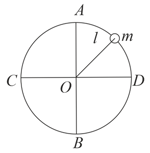
A stone tied to a string is rotated in a vertical circle. The minimum speed of the stone during a complete vertical circular motion
A body of mass is whirled in a vertical circle making . If the radius of the circle is , then tension in the string when the body is at the top of the circle, is:
A small block is shot into each of the four smooth tracks as shown below. Each of the tracks rises to the same height. The speed with which the block enters the track is the same in all cases. At the highest point of the track, the normal reaction is maximum in
A point mass is hanging by a string of length The velocity which must be imparted to it in order for it to just barely reach the top is
A pendulum is made of a rigid rod (mass length ) and a small bob of mass attached at one end (as shown in the figure). The rod is pivoted on the other end. What should be the minimum speed of the bob at its lowest point so that the pendulum completes a full circle ?

A pendulum string of length moves up to a horizontal position as shown in figure and released.
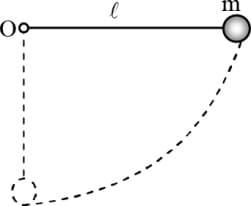
What should be the minimum strength of the string to withstand the tension as the pendulum passes through the position of equilibrium? The mass of the pendulum is .
A particle slides from the top of a smooth hemispherical surface of radius R which is fixed on a horizontal surface. If it separates from the hemisphere at a height h from the horizontal surface, then the speed of the particle is:
A particle is tied to a string describes a vertical circular motion of radius continually. If it has a velocity at the highest point, then the ratio of the respective tensions in the string holding it at the highest and lowest points is
A bucket, full of water is revolved in a vertical circle of radius The maximum time period of revolution so that the water doesn't fall out of the bucket is
A particle is attached at one end of a string of length whose other end is fixed. It is moving in a circular path in the vertical plane such that at any position. The tension in the string is and the acceleration of the particle is . The velocity of the particle at the lowest point is . Then find the condition at which will be positive at the lowest point.
A particle is projected horizontally from the top of a smooth sphere of the radius with a velocity so that it slides down the outside of the sphere. After falling through a height of , the particle leaves the sphere. Find the value of .
A bob of mass of a simple pendulum of length displaced from position to . is height above the position . Then it is released from the position . The velocity of the bob is at . Find the tension in the string when the bob passes through the equilibrium position (neglect friction).
Figure shows a small ring is threaded on a smooth wire bent in the form of a circle of radius and centre . The wire is rotating with constant angular speed about a vertical diameter , while the ring remains at rests relative to the wire at a distance from . What is the value of ?
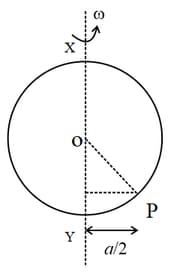
A simple pendulum is made by suspending a bob with a light string. The bob is imparted a horizontal velocity such that it just completes full circular trajectory in vertical plane. What is the difference in tension between lowest and highest point of path?
A pendulum has an angular amplitude . Tensions in the string when the pendulum is at the extreme position and at the bottom are and respectively. If , then is equal to :-
A small block of mass slides along a smooth frictional track as shown in the figure. The block starts moving from at rest. Find the resultant force acting on it at .
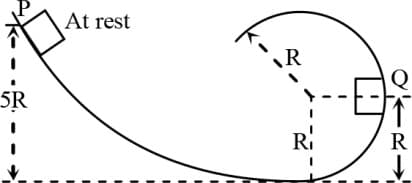
Block is placed on the wedge at a height above the ground. Block and the two wedges are of the same mass . Neglect friction everywhere.
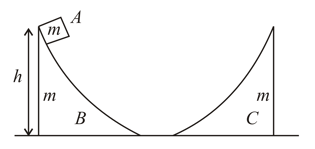
Find the velocity of when it has slid down to the ground from wedge .
A uniform rod of mass and length was held in a horizontal position and one end of this rod is fixed. Now the other end of this rod is attached with a point mass and is given a speed in the vertically downward direction such that the point mass just reaches the topmost point. The initial speed given to the ball is
A uniform rod of mass and length was held in a horizontal position and one end of this rod is fixed. Now the other end of this rod is attached with a point mass and is given a speed in the vertically downward direction such that the point mass just reaches the topmost point. The change in potential energy of the system (point mass+rod) is
